Experience in working with trends is significant for every trader. If you don’t know how to determine a trend, you won’t succeed. This article will present you with a millennial-age oscillator that will help you become an absolute genius of trend analysis. Prepare to learn more about the Aroon oscillator indicator!
What Is Aroon Indicator?
The Aroon indicator was developed by the market-leading technical analyst Tushar Chande in 1995. "Aroon" comes from the Sanskrit language and means "Dawn's Early Light." This is a technical indicator that helps to identify trend changes and the strength of a current trend. Moreover, it can help to see the end of a consolidating market and the beginning of a new trend.
Aroon consists of two separate parts: AroonUp and AroonDown.
AroonUp measures the time that passed since the price has made a high within a particular period. If the current bar’s high is the highest within the considered period, the AroonUp value will be 100. Otherwise, it returns a percent value indicating the time since a new high of the period occurred.
AroonDown measures the time passed since the price has made a low within a particular period. Alternatively to AroonUp, if the current bar’s low is the lowest within the considered period, the AroonDown value will be 100.
The AroonUp and AroonDown lines are placed on one another and show the movements between the 0 and 100 values. By standard, the indicator is applied to 25 periods. This way, it shows how much time has passed since the price posted a 25-day high or low.
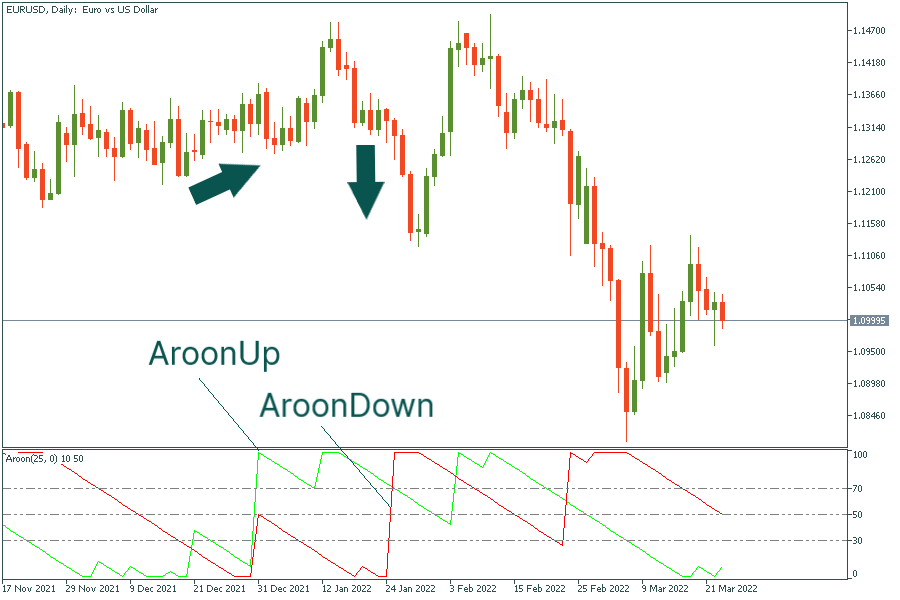
How to add Aroon Indicator to MetaTrader?
You can’t find the Aroon oscillator in the standard set of MetaTrader instruments. However, this indicator is available for a free download from the official website of MetaTrader. If you are an TradeGlide trader, you can download our version of the indicator.(ask admin)
The password for this folder would also be given to you
To add the Aroon Indicator to MetaTrader, click File – Data Folder and place the downloaded file into the folder. After that, you need to reload the software. The oscillator will appear in the program. You can add it to the chart by clicking Insert – Indicators – Custom – Name of the indicator.
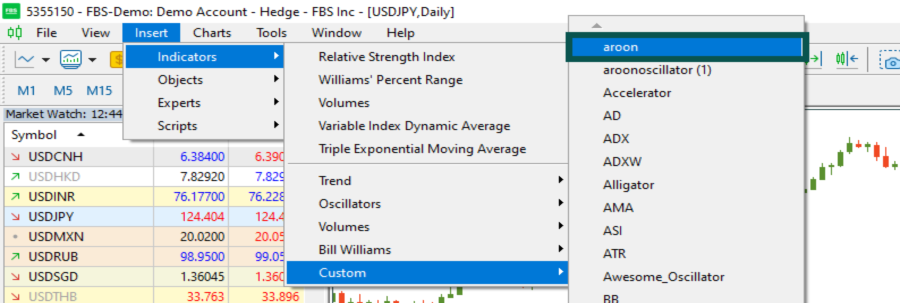
How to calculate the Aroon Indicator?
If you look at the formula of the Aroon Indicator for the first time, you may think that it's kind of complicated. It’s a lot easier than it seems. In the equation below, we present standard calculations of the Aroon Indicator with 25 periods.

To make calculations in the formula above, you need to follow the following steps:
- Track asset’s highs and lows for the last 25 periods.
- Remember the number of periods since the previous high and low.
- Insert the numbers in the formulas above.
Luckily, you don’t need to calculate it yourself, as MetaTrader software calculates it for you.
Differences between Aroon and AroonUp/AroonDown indicators
Apart from a classic Aroon Indicator developed by Tushar Chande, there is also an adaptation of this indicator. You can find it on the official website of MetaTrader 5. You can calculate it by subtracting Aroon Down from Aroon Up. It’s represented as a single line balancing between -100 and 100 values. In general, the Aroon one-line indicator uses the same trend-identification secrets. It signals an uptrend if it moves towards its upper border and a downtrend when it moves towards the lower one.
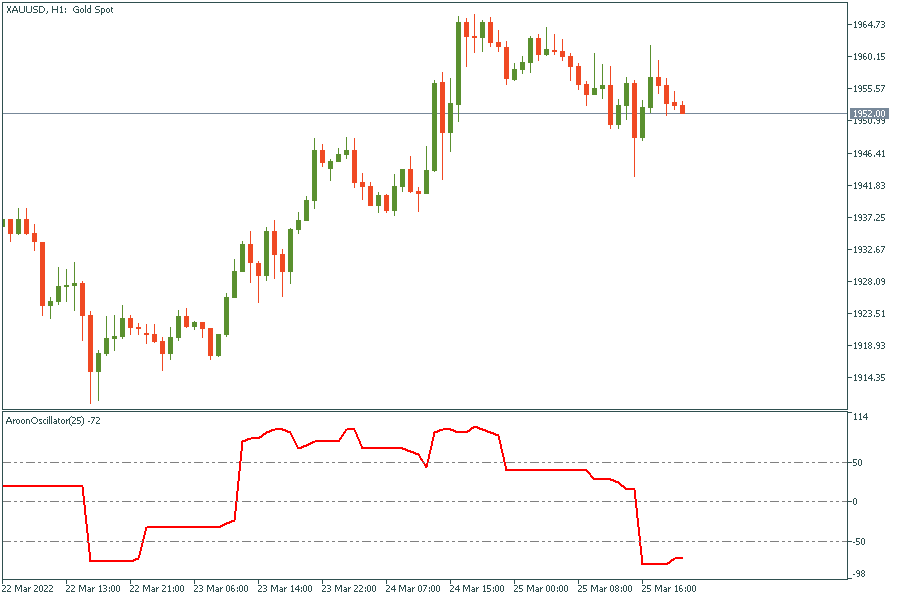
How to Read the Aroon Indicator?
If you look at the Aroon Indicator in MetaTrader, you can notice that apart from zero and 100, it has three more levels: 30, 50, and 70. The standard colors of the indicator are green (for AroonUp) and red (for AroonDown). How to use the Aroon Indicator?
First, you can use it to see the main trend
The most basic interpretation of this oscillator is general trend identification. If AroonUp is above 50, and AroonDown is below 50, the market is bullish. On contrary, if AroonDown is moving above 50, and AroonUp is below 50, it demonstrates the downtrend.
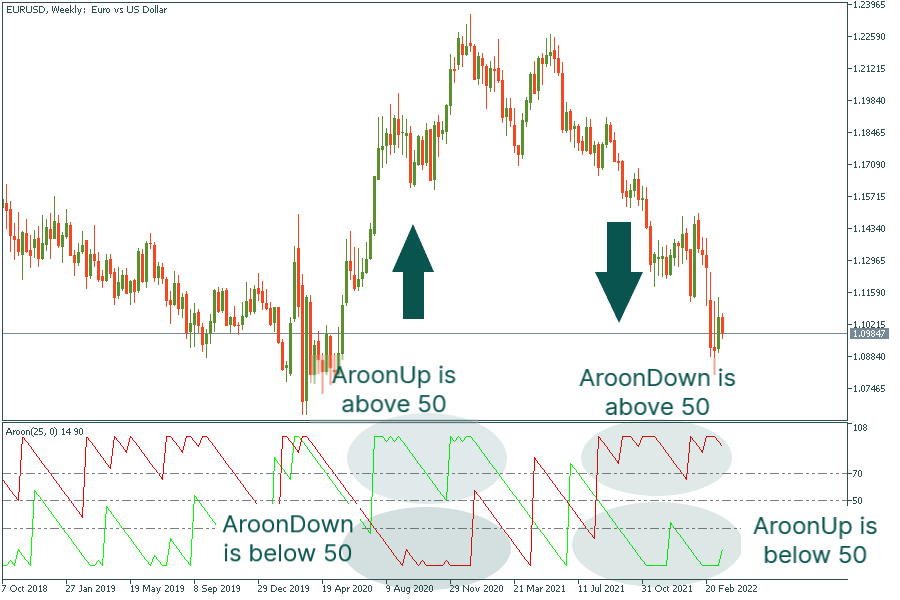
Second, you can identify the beginning of a new trend
When the AroonUp crosses above the AroonDown, it signals the beginning of an uptrend. The signal is stronger when the AroonUp breaks above 50 and AroonDown moves below 50. Finally, if AroonUp is nearly at 100 and AroonDown is at 0, this is a proper signal that the uptrend will last for long.
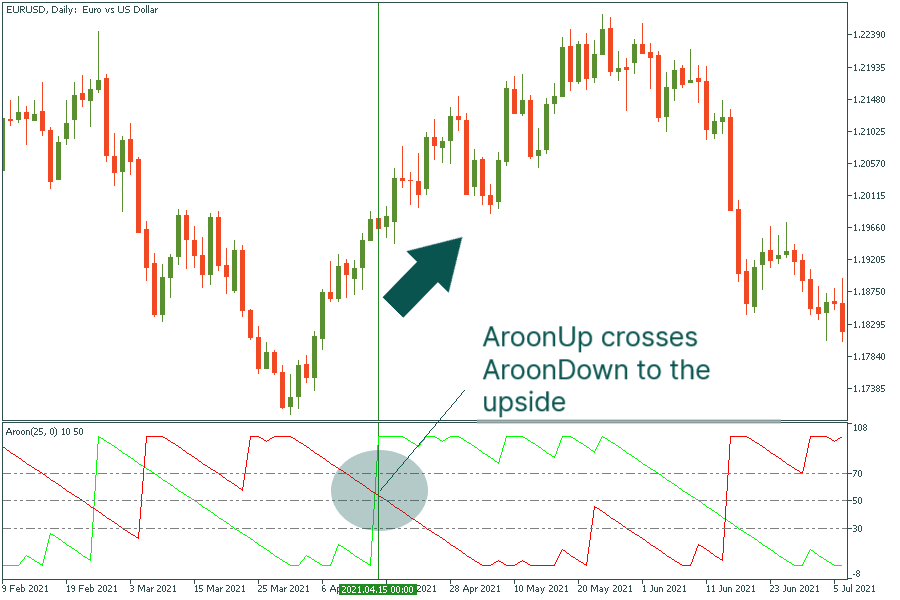
For a downtrend, we need to see AroonDown crossing above AroonUp. If Aroon breaks above 50 and/or reaches the 100 level, while AroonUp goes below 50 and/or reaches the zero level, this indicates a downtrend.
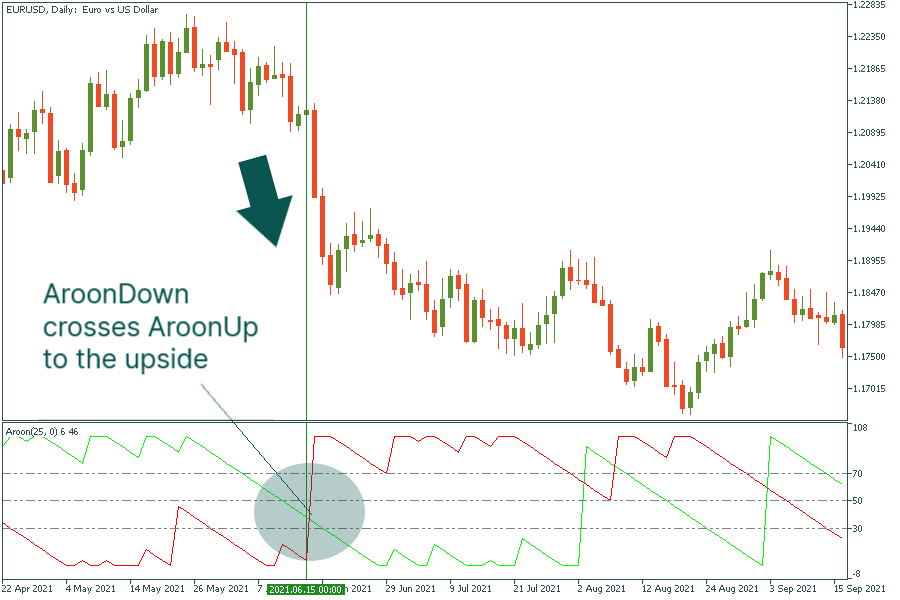
Third, you can look for consolidations
If both AroonUp and AroonDown are below 50 or both of these lines move lower in parallel, this is a sign of a consolidation emerging. If both AroonUp and AroonDown are below 50, no new highs or lows have been recorded.
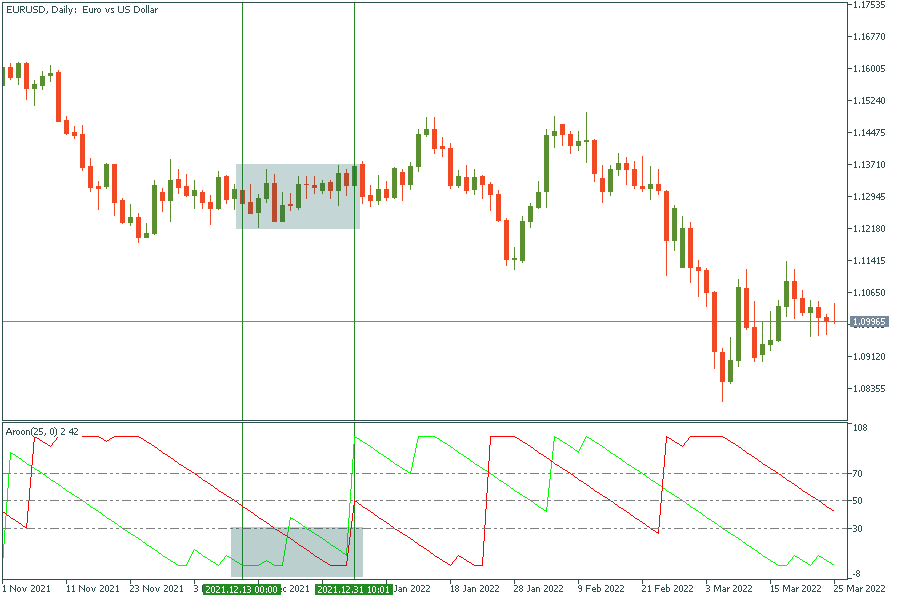
If both lines move lower in parallel, it indicates the beginning of a ranging market, with no new highs or lows recorded.
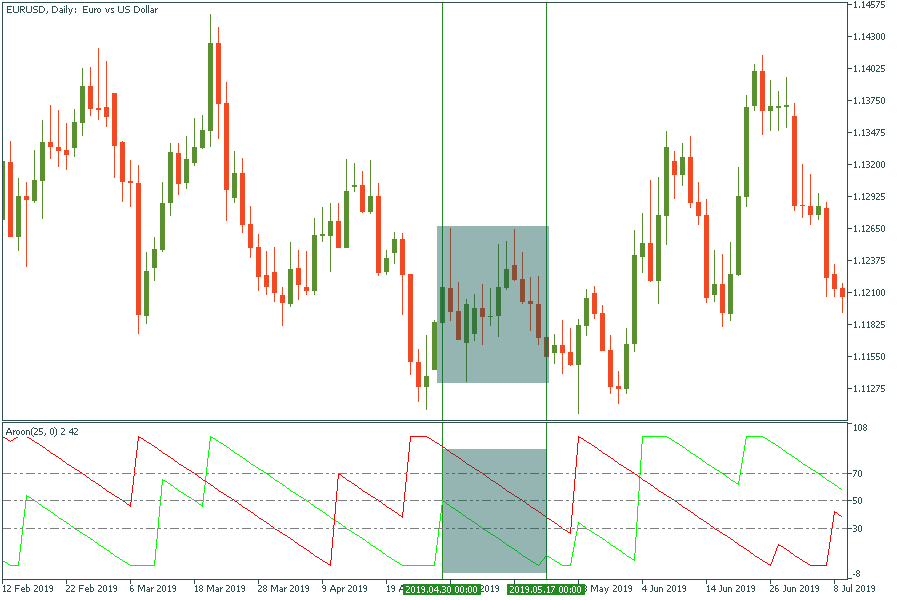
Fourth, you can identify entry signals
Some traders use the Aroon Indicator to identify a potential entry. For example, if AroonUp crosses above AroonDown, it can be a signal to buy. Vice versa, AroonDown crossing below AroonUp is a "sell" signal. It's crucial to use additional confirmation signals (for instance, from other oscillators) before entering a trade. If the market is choppy, the indicator will produce poor signals due to fast changes in the price. Also, due to lagging, the indicator may provide a late trade signal. Thus, a check-up and thorough analysis is highly recommended.
Aroon Indicator Strategies
There are two main strategies you can implement using the Aroon indicator. They are breakout and trend-strength strategies.
Breakout Strategy
The breakout strategy is based on finding the consolidation and waiting for a crossover of a range's border. Let's look at the main steps.
- Find a consolidation.
- Wait for a breakout signal on the Aroon Indicator (the crossover of lines followed by the 50-line crossing).
- Expect for a breakout of consolidation border to avoid false signals.
- Enter a trade in the direction of a breakout. Don’t forget to place a stop loss near significant support/resistance line.
- Exit a trade when it reaches the next significant level.
Let’s consider an example.
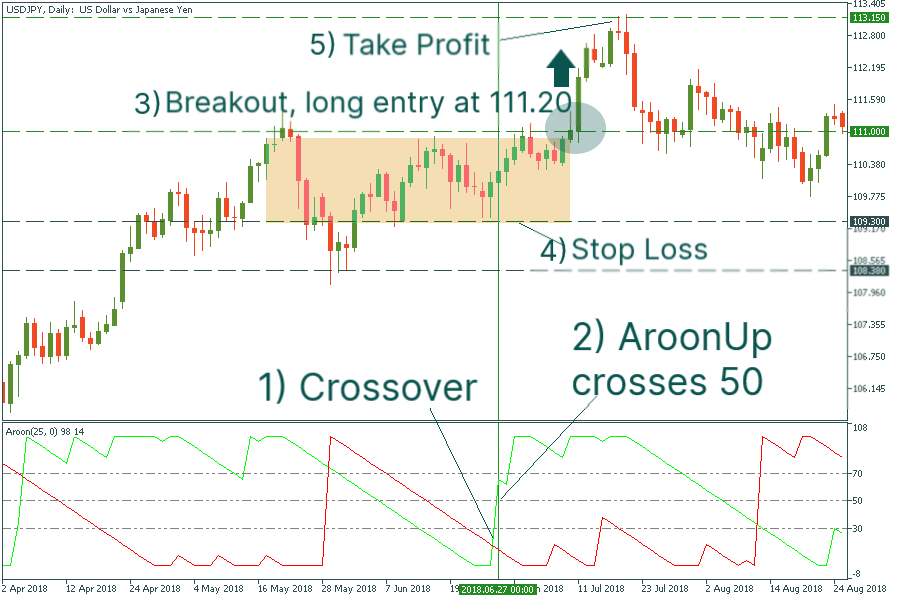
On the daily chart of USDJPY, the price was consolidating between 109.3 and 111.00. It confirms the consolidation. The Aroon lines were below the 30 level. After the AroonUp crosses AroonDown to the upside, we wait for additional signals to enter a long trade. These signals were the breakout of the 50 line by AroonUp and a strong break of the upper border of consolidation at 111.00. We placed the entry point at 111.20 and Stop Loss at 109.30. The Take Profit went at the previous significant resistance level at 113.15.
Trend-strength strategy
The second strategy is related to the following of the strong trends. You already know from the previous paragraphs that the uptrend is considered strong when AroonUp is at the highest levels (close to 100) and AroonDown moves below 50. In a downtrend, AroonDown should be near 100, and AroonUp should be below 50.
For a long entry, you need to complete the following steps.
- Wait for AroonUp to cross the 70 line and AroonDown below 50.
- Place a long entry on the next candlestick after the cross.
- Place a Stop Loss at the previous significant support level.
- Close your order manually when the reversal signal, the opposite crossover of the Aroon lines, emerges.
Let’s look at the example. On the daily chart of USDJPY, we waited for AroonUp to cross the 70 line and AroonDown to fall below 50. We opened a long trade at 110.90 and placed Stop Loss several points below this level at 109.70. We closed the trade at 113.90 when AroonUp fell below 30.
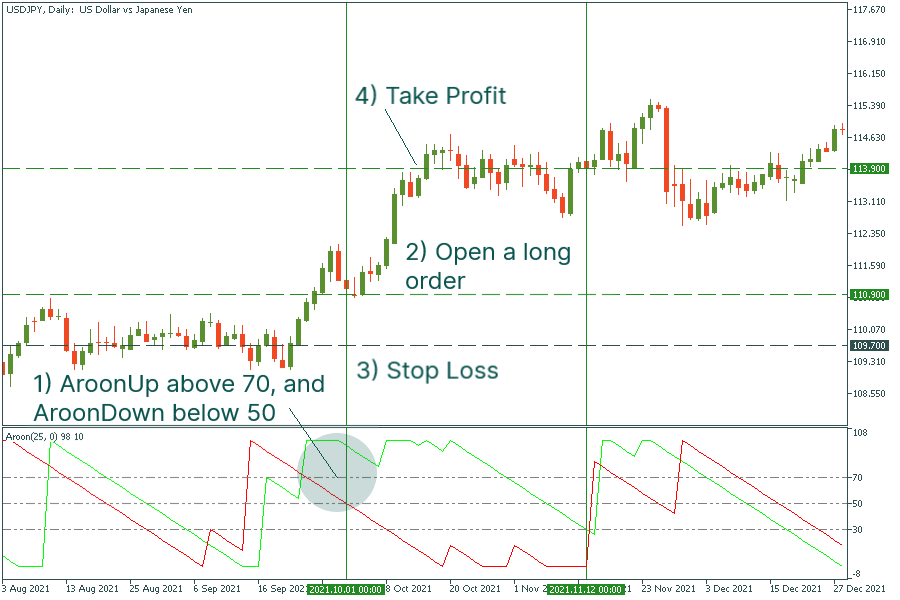
For a short entry, you need to do the following algorithm:
- Look for a crossover. AroonDown should cross the 70 line. AroonUp should fall below 50.
- Place Stop Loss several points above the entry or near the closest resistance.
- Close your trade when AroonDown falls below the 30 line.
Aroon Indicator and ADX
Some traders may find the Aroon Indicator similar to ADX. Both show the trend direction and help see the strength of a trend. However, the calculations of these indicators are entirely different. The Aroon lines focus on the time between highs and lows, while the ADX formula is more complex. You can compare both indicators in the picture below.

Aroon Indicator and RSI
If you want to know what oscillators work best with Aroon, we highly recommend combining it with RSI. You can use RSI as an additional signal of a reversal when it forms bearish/bullish divergence, and AroonDown/AroonUp crosses the 50 line to the upside.
Advantages and disadvantages of the Aroon Indicator
Like any other oscillator used in technical analysis, Aroon has advantages and drawbacks.
Among the pros, we can mention accuracy with defining trends, efficiency, excellent and clear signals of a trend's reversal.
The main disadvantages are lags, false signals during the sideways markets, and the need for confirmation of signals.
Bottom Line
If you want to trade trends or have a problem with trend identification, the Aroon Indicator will be a fantastic choice. It's very understandable and serves as a good signals provider. Just be sure that you use additional confirmations. Don't make an indicator a holy grail, and success will be on your side!








No comments:
Post a Comment